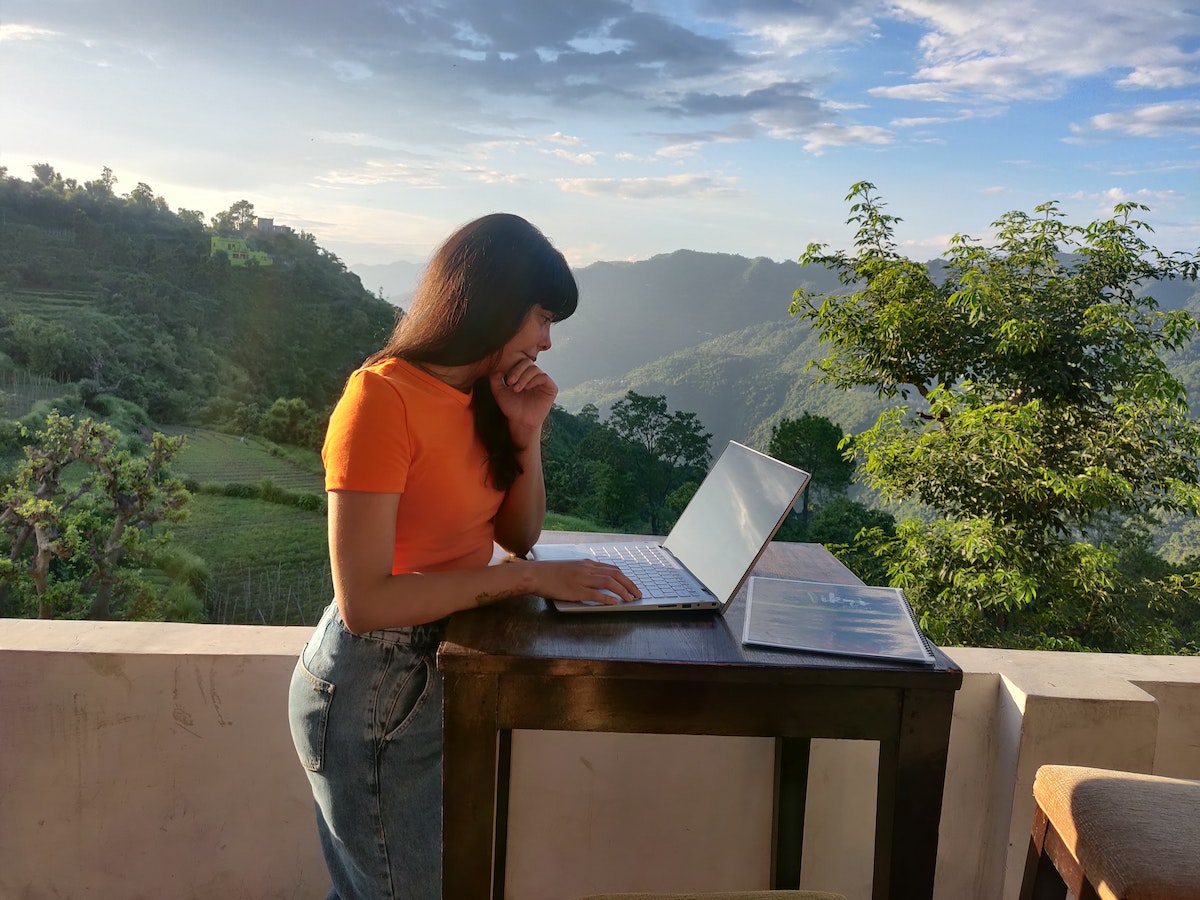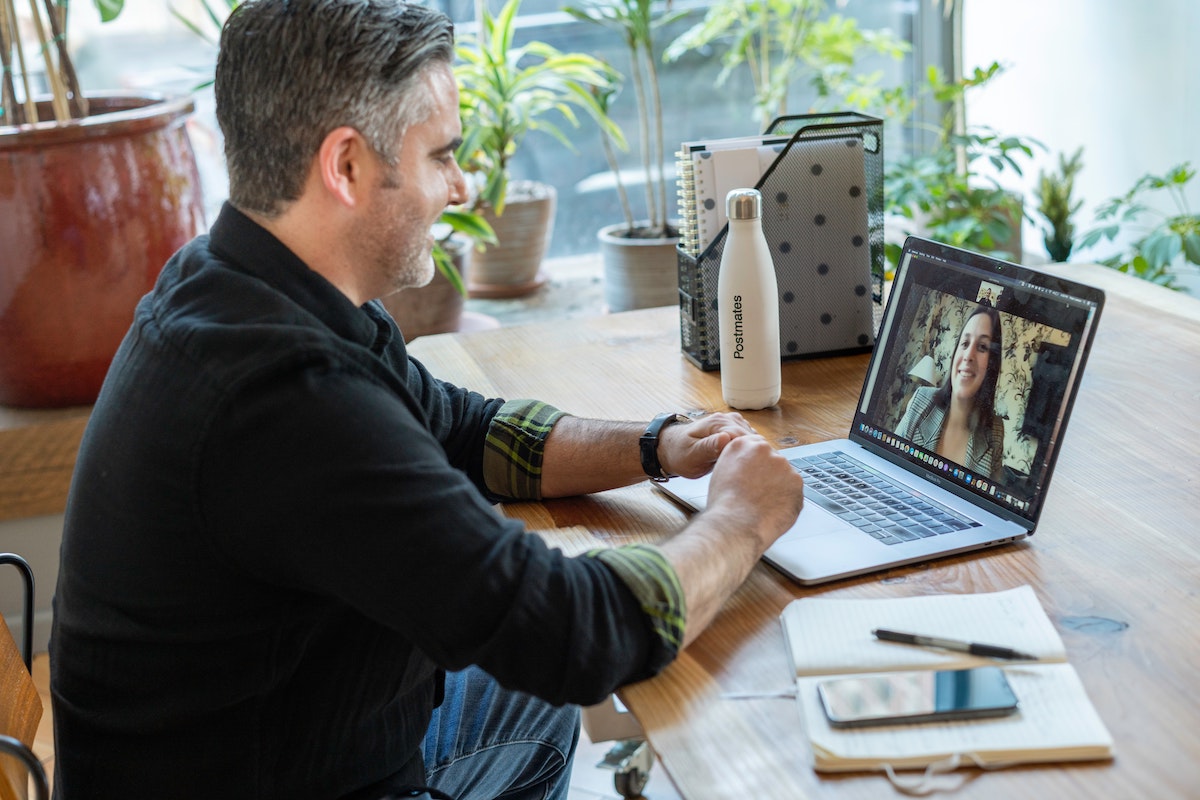By: Sarah Stone
Skip to...
In early 2020, 4.7 million people in the US were working remotely. That was before the COVID-19 public health crisis took hold, forcing companies overnight to develop remote working capabilities if they hadn’t offered them before—or to extend those opportunities to employees who were not given the option previously. Whether you are one of these newly-remote employees, or if you’re somewhere outside of that, and looking for a way to move toward a more location-independent setup, our guides to digital nomad and remote work lifestyles are here to help you plan it out.
In this guide, I’ll talk about how to use Creative Problem Solving to plan your move to a laptop lifestyle. Using the basics outlined by Jeffrey Baumgartner in this article on InnovationManagement, you can tackle tough questions and make actionable plans through:
- Identifying the problem
- Researching the problem
- Developing creative challenges
- Generating ideas
- Combining and evaluating those ideas
- Drawing up an action plan
- Getting it done
Let’s have a look at each step in the Creative Problem Solving process to get you on your way to a more permanent remote work lifestyle.
Identify the Problem

Photo by Dessidre Fleming on Unsplash
Kind of like writing an introduction to an essay, narrowing down the exact problem you’re trying to solve won’t always come to you immediately. You may be worried, stressed, or frustrated, and those feelings can cloud your view, making the problem seem too complicated or too overwhelming to solve. Breaking your problem down into smaller pieces can help you find the exact pain points that must be addressed—and it may turn out the problem isn’t the unsolvable mess you thought it was.
A few questions to help define the nature of your problem:
What specifically isn’t working for me right now?
As frustrated and stuck as you may feel, your answer shouldn’t be “Everything.” Try to identify specific aspects of your situation that aren’t sustainable, or that are pushing you away from your current spot.
Example: I hate my commute. I spend an hour-and-a-half commuting every day, and I want to be able to spend that time with my family, getting other projects done, relaxing, or doing literally anything other than wasting my time driving or taking public transportation to the office—especially when I know my job can be done remotely.
Are there aspects of my situation right now that I’m good with, and don’t need to change?
These can include things you’re neutral about too! Maybe not every single part of your job, or the situation you’re in, is worth throwing out.
Example: I like the actual work I’m doing, and I’m pretty good at it. I truly dislike going to the office, and I feel like I’m way more productive at home. Everyone says to go freelance, or try a different skill, but maybe I don’t need to flip the table entirely—I don’t hate the nature of my work, and I know I’m getting good things accomplished with my company.
Why do I want to change my situation?
This is a bit different from what you don’t like about your situation—think about what values you’re holding that may be urging you to make a change. Why do you consider certain pain points to be important?
Example: It’s so difficult to be as productive as I want when people are stopping by my desk to chat, popping in for questions, or pulling me into unnecessary meetings. The context change between interruptions and getting back to my work wastes so much time, and I’ve found that if I work from home, uninterrupted, I can get more accomplished. The time that I save allows me to do other things—I can learn new or different skills, finish work that’s been on the back burner, or even take some time to exercise, make a healthy meal, or do something else to better myself personally.
What’s holding me back from achieving this lifestyle?
This is another question that you may need to take time to think through in detail. What are the specific blocks in your way toward working remotely, full-time? While your commute may be something you want to change, the commute itself isn’t necessarily a blocker—the purpose of the commute is your blocker in this scenario.
Example: My workplace has never been open to remote working policies until they’ve been forced to with COVID-19. I don’t think they will continue letting anyone work from home once we’re all allowed back into the office, and it already seems like they’re going to use the awkward transition and technological hiccups as an excuse for why remote working will never be an option. Should I start looking now for different jobs, or should I try to convince my supervisor at least to let me work remotely long-term?
How have others built a lifestyle similar to what I’m looking for?
Learning about how others have tackled similar scenarios can help you define your own problem. Read stories about how others have transitioned to a fully-remote lifestyle, and look for examples of people who’ve been in similar situations as yours. Are you out of work right now, and searching for online-only positions? Are you interested in making a change to a totally different type of work from what you have right now?
Example: I work in the service industry, and am out of the job right now. I’m good at writing, but I don’t know where to start with finding writing jobs. The freelance platforms that I know of are full of people charging pennies, or who already have tons of reviews. How do I get started, even with a couple of small jobs, when I’m competing with so many other, more established people? How do I know I can make enough money to live? How have other people done this? Is there anyone I can talk to about how they went from, say, bartending to writing? Do my friends, family, or other connections know anyone I can talk to? Are there blogs or how-to’s I can find for getting started with writing jobs?
As you think through your problem, set some criteria for evaluating the solutions you’ll generate later in your Creative Problem Solving exercise. Come up with a list of three or more ways you’ll evaluate your potential solutions. If you’ve decided that your problem is that you want to find a totally different job where you can work remotely, some criteria may be:
- I need to make a minimum of $30,000 per year to cover my current living expenses, and to add to my savings
- I want to avoid jobs in graphic design
- I need to be able to work during my own hours, rather than 9:00am to 5:00pm EST
- I would like to use my research skills in my job
- I want to be able to start this job within six weeks
We’ll come back to the criteria in the idea evaluation phase.
Research the Problem
Understanding your problem better will help you not only define it in more detail, but also get you on your way to solving it. For each of the questions, pain points, or to-do’s you’ve already created, delve into them and learn how others have tackled those issues.
Here are a few resources on Frayed Passport that can help get you started:
- Directory of Digital Nomad Resources: You don’t have to go abroad to use a lot of these resources! The directory includes a list of job search sites that may be of interest to you as a jumping-off point.
- How to Ask Your Boss to Work Remotely: An in-depth explainer on the steps you can take to encourage your workplace to build a remote work culture.
- Budget Ideas for Digital Nomads: Whether you want to work from home or make the world your home, this guide covers how to plan your budget when you’re working entirely online.
- 10 Best Semi-Retirement Jobs: Semi-retirement may sound like an unreachable goal, but it may not be! This guide covers 10 different jobs that you can take on remotely either part-time or full-time if you’re looking for a change.
- 8 Must-Have Writing Apps for Travel Writers: …or for any type of writer. Get your freelancing career off the ground with the help of these super useful writing apps!
- How to Create a Pension for the Average Joe: If you’re worried about saving for retirement, especially if you go freelance or otherwise have a shake-up in income, this article can help you.
- 8 Writing Habits to Avoid when Pitching an Editor: If you’re interested specifically in writing, here are some tips to help get your writing in front of an editor.
Outside of Frayed Passport, a few resources to look at can include:
- Books and long-form articles about your topic.
- Our good friends at Retire Early Lifestyle have published several books for people looking to break out of their 9-to-5 jobs, and move toward remote positions, and even retire early and earn passive income.
- Blogs by people who have accomplished what you’re looking to do as well.
- Because Frayed Passport is a travel site, our recommendations are mostly in the digital nomad space—but you can apply all of these lessons even if you want to work from home, without traveling. A few recommendations for remote working blogs include Become Nomad, Digital Nomad Girls, Expert Vagabond, Making It Anywhere, and Nomadic Matt.
- Facebook groups and other forums for people in the same boat. Actually, I’d even recommend joining groups not just for people in the same boat as you, but who are already on the next phase—that is, people who already are working remotely and are sharing resources amongst each other.
- How-to guides by official sources—for example, this federal government guide to developing remote working plans can be incredibly helpful for companies and organizations as well.
Learning as much as you can about the problem, and how others have addressed it, can make it seem less overwhelming and more solvable.
Develop Creative Challenges

Via Yayimages
Once you’ve narrowed down the problem (or problems) you’re trying to address, move along with your Creative Problem Solving exercise by writing out very simple creative challenges. The purpose of this exercise is to set you up for the idea phase, where you’ll develop innovative solutions to your problems.
In general, these will be “How do I…” or “How can we…” questions.
Challenge questions should focus on one single problem. As Mr. Baumgartner notes in his article on Creative Problem Solving, “‘How might I improve my Chinese language skills and find a job in Shanghai?’ [are] two completely separate challenges. Trying to generate ideas that solve both challenges will be difficult and, as a result, will stifle idea generation. So separate these into two challenges: ‘How might I improve my Chinese language skills?’ and ‘How might I find a job in Shanghai?’ Then attack each challenge individually.”
He also notes that challenge questions shouldn’t be constrained by evaluation criteria. Instead of saying, “How can I find a remote job that will pay me $30,000 per year,” just leave it at “How can I find a remote job?” so that the ideas you generate will be more creative and less boxed-in.
A few challenge questions you might ask:
- How can I find a remote working position?
- How can I convince my boss to let me work remotely?
- What can I do to become a freelancer?
- How can I build new skills in my free time?
- How can I translate any of my skills to online work?
Generate Ideas

Photo by LinkedIn Sales Solutions on Unsplash
This is the fun part of Creative Problem Solving! Get some notecards or post-it notes, or open your notes app, and start writing down at least 50 different ideas relating to your challenge statement (or statements). Write out the most ridiculous ideas. If one suggestion for “How can I become a freelancer?” is “Become a private detective,” write it out because it can be surprisingly useful. Jot down everything that comes to mind—don’t skip any of those ideas!
If you have friends or family helping out, make sure that it’s a totally open, non-judgmental space: all ideas are valid, even if someone thinks they’re laughable, dumb, or totally unworkable. Build on each other’s ideas, too! One suggestion might inspire another, or a theme may even emerge.
If you’re stuck before you get to 50 ideas, try the following:
- Go to a different space, whether it’s another room, your back yard, or somewhere else, and see if you have new ideas there.
- Think about what a fictional character might suggest (even characters you don’t really relate to).
- Use a random word to generate an idea—open a book, click over to an article, or check out a random word generator online, and use that word to formulate your next thought.
- Change the way you’re writing out ideas—if you’re using a notes app, switch to post-its.
- Put the project on hold and come back a day or two later.
Combine and Evaluate Your Ideas

Via Unsplash
After you’ve got everything written out, walk away. Much like editing your own writing, if you’ve been entrenched in the project and staring at it for a while, you tend to lose sight of your goal, and details can drop into your periphery. Go do something else for a while—cook a meal and go for a bike ride. Revisit your ideas the next day. Wait until the next weekend to gather your thoughts.
Remember the criteria you wrote up for evaluating your ideas? Now is when you’ll put that list to use: take all of the ideas you’ve generated, and sort them into your different criteria. You can put a single idea into multiple categories. Some ideas won’t fit anywhere at all.
Even if an idea you’ve generated only barely fits, sort it into its corresponding category anyway! “Become a private detective” sort of falls into the category “I want to use my research skills,” so don’t toss it—it could lead you to a remote job of fact-checking for online publications.
If your problem is a bit more complex to solve—and transitioning to remote work may be just that—you may need to find additional ways to evaluate your ideas. One thing that worked for me when moving from the 9-to-5 office to building an online business was to draw a chart outlining:
- What tasks do I like to do?
- What am I neutral about?
- What tasks do I dislike doing?
- What am I good at?
- What am I not-so-good at?
- What am I either not-so-good at, or “meh” with, that I would like to improve?
My intent was to figure out how to build a business where I could do things I liked or was totally neutral about, and that I wanted to do more of or learn more about. My initial assumption was to become a freelance website designer—but that’s not what actually happened. I plotted out all of the different types of tasks I took on in my jobs over the years that could conceivably be done remotely, and found, among other things, that:
- I was good at general website management (updating plugins, building new pages, moving content around), and had neutral feelings toward it.
- I was somewhat ok at website design, but didn’t really like to do it unless someone else was driving the design portion while I was building it out.
- I was not-so-great at website backend development (managing servers, tearing down and rebuilding websites, adding new capabilities to websites), but I loved learning more about it and definitely wanted to do more of it.
- Of any skills, I was best at organizational and detail-oriented work (finding discrepancies in documents, editing articles, cleaning and segmenting email lists), and I loved it.
- I was ok at developing action plans, and loved it and wanted to get better at it.
- I was ok with developing reports and guides, and wanted to get better at it and do more of it.
- I was not good at PR, and very much disliked doing it.
- I was not good at graphic design, and didn’t like to do it.
I immediately noticed that I wasn’t great at or terribly interested in visually creative work, but was interested in some aspects relating to it. I loved thinking of ways to improve things, and developing plans for how to get there. I didn’t like designing websites, but I loved managing all of the backend parts that designers tend not to pay as much attention to, or be as well-versed in. I loved fixing things, and finding new ways to make things work better!
So now I work remotely as an independent contractor fixing and managing websites (and email lists, and other marketing materials), and finding ways for companies to reach new markets and implement new development strategies. My work evolves constantly, and making a new chart and revising my evaluation criteria helps to keep track of what I’ve learned, what new skills I’ve developed, what I’ve moved past, and what I need to do to ensure I’m able to always work for myself, remotely.
Draw up an Action Plan

Photo by Good Faces on Unsplash
In this Creative Problem Solving phase, you’ll look at the ideas you’ve chosen that fit into your evaluation criteria—the ones that make sense of your problem and what needs to be done about it. Combine similar ideas, and write them out into an overall statement of what you need to do to accomplish your goal. This can be a paragraph, some bullet points, or a few pages, or even longer.
Look back at the research you conducted around your problem, and see how your ideas apply to that research. Do they relate to the initial problem you were trying to solve, or do you need to do more research in a slightly different direction? Go back and find resources to help develop your action plan—read articles, blogs, and books; join groups and forums; check out job openings relating to your preferred work, even if you’re not planning to apply to them; connect with people you can learn from, and start developing a step-by-step process to move from your current situation to a fully remote work environment.
Note: You don’t have to write Point A to Point Z in order—think of everything you need to do, and try to put them into an order that makes the most sense. Fill in the details—you might need to write out Points C, D, and E first before you figure out what Points A and B are. But getting them on paper, and making every single step a specific action that you can take, will serve as your roadmap.
Get it Done!
It can be incredibly difficult to get started—but as with tackling any large project, breaking it down into the smallest components, and getting at least one thing done today will set you on your way to success.
As you move forward with the Creative Problem Solving process and implementing your action plan, keep track of all of your accomplishments, celebrate your victories, and make note of any obstacles you encounter, and how you’re overcoming them. If you become discouraged, revisit your notes and see how far you’ve come! Revise your action plan if need be, and keep moving forward until you’ve accomplished your goals.
About the Author
 As the editor-in-chief of Frayed Passport, my goal is to help you build a lifestyle that lets you travel the world whenever you want and however long you want, and not worry about where your next paycheck will come from. I've been to 20+ countries and five continents, lived for years as a full-time digital nomad, and have worked completely remotely since 2015. If you would like to share your story with our community, or partner with Frayed Passport, get in touch with me at sarah@frayedpassport.com!
As the editor-in-chief of Frayed Passport, my goal is to help you build a lifestyle that lets you travel the world whenever you want and however long you want, and not worry about where your next paycheck will come from. I've been to 20+ countries and five continents, lived for years as a full-time digital nomad, and have worked completely remotely since 2015. If you would like to share your story with our community, or partner with Frayed Passport, get in touch with me at sarah@frayedpassport.com!
Featured image via Unsplash.



